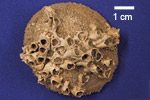Falls of the Ohio State Park
|
||||||
Location: Clark County, Indiana, and Jefferson County, Kentucky
Time: 392 to 380 million years ago, during the Devonian period
About this Famous Find: Fossils of the Jeffersonville Limestone are exposed in limestone outcroppings that made up a set of rapids in the Ohio River that stretched shore to shore (a mile wide) and about 2.5 miles long. The Falls were an important hunting and fishing site and as a result, Native Americans collected fossils which they used for ornamental purposes (found in riverside archaeological sites) dating from 3,000 to 10,000 years ago. The earliest European fur traders plied the Ohio River in the late 1600s to early 1700s and rediscovered the fossil wealth. Specimens were shipped to the great museums of Europe. The McAlpine Dam reduced the size of the fossil beds to a mere 200 acres during low water. Exposures containing fossils can be found throughout Clark County, Indiana and Jefferson County, Kentucky.
The Jeffersonville Limestone is a coral-stromatoporoid bioherm containing the most diverse Middle Devonian tabulate and rugose coral assemblage in North America and possibly the world, with several hundred species described. When the Ohio River is low (typically midsummer through autumn), it is possible to walk on a single bedding plane in the coral zone that covers many acres and see large tabulate and colonial rugose corals in situ. Smaller corals, including numerous rugose “horn” corals can be observed in jumbled masses between the larger ones in vast numbers. One horn coral, measuring four feet in length, is the largest in North America according to the late coral expert William A. Oliver, Jr. The coral zone straddles the Emsian-Eifelian contact.
The Jeffersonville Limestone has many other phyla including sponge-like stromatoporoids, brachiopods, bryozoans, echinoderms (blastoids and crinoids), mollusks (bivalves, cephalopods, gastropods, rostroconchs, etc.), trilobites and trace fossils. Bone beds contain teeth, scales and bone fragments of paleoniscid, acanthodian, arthrodire, crossopterygian, and other primitive fish. Smaller fossils include conodonts, foraminifera, ostracods and charophyte alga oogonia. Nearly 600 species have been described from the Jeffersonville Limestone and the overlying Sellersburg (North Vernon) Limestone. The top of the Sellersburg Limestone contains the Givetian-age Beechwood Limestone. It contains a diverse coral and crinoid assemblage.
During the Middle Devonian, the Falls of the Ohio fossil beds region was covered by a shallow, tropical sea located some 30 degrees south of the equator. Evidence of potent tropical storms is visible because all but the largest corals and stromatoporoids have been jumbled around. While the organisms are different, the Jeffersonville Limestone ecosystem is comparable to a patch reef ecosystem in Florida Bay or the Bahamas today.
Fossils from the Jeffersonville Limestone can be found in museums around the world. The state park’s interpretive center and the Indiana State Museum contain the largest displays, but specimens have been exhibited at museums with major fossil exhibits. Major collections are located in the Field Museum of Natural History, Harvard Museum of Comparative Zoology, the Smithsonian, Yale’s Peabody Museum, Indiana State Museum, and others. Fossils can be viewed on the park’s website and Facebook page. The park's website also has on-line brochures describing the fossils and geology of the Falls of the Ohio.
OrganizationsWhere to Collect Fossils (1 listing)
Falls of the Ohio State Park Collecting Information: A brief guide to legal fossil collection sites in Kentucky and Indiana.
Education and ExhibitsParks (1 listing)
Falls of the Ohio State Park: The 386-million-year-old fossil beds in the park are among the largest naturally exposed Devonian fossil beds in the world.
ResourcesVirtual Exhibits (3 listings)
The Fossils of Falls of the Ohio State Park: Brochures and other information describing the park's fossils and geology.
A Virtual Tour of the Falls of the Ohio State Park: A multi-page tour of the park with photos of various features and fossils.
KET Electronic Field Trips: Falls of the Ohio: The geologic history and ecology of the Falls of the Ohio area.
Image Collections (1 listing)
Falls of the Ohio Fossil Photos on Facebook: A collection of photographs of fossils taken at the State Park.
Field Guides (2 listings)
Pseudofossils: This illustrated guide to pseudofossils on the Falls of the Ohio State Park website helps you to tell the difference between a real fossil and a pseudofossil, a rock that only looks like a fossil.
Devonian Corals of the Falls of the Ohio and Surrounding Areas: Descriptions and photos of some of the corals to be found at the Falls of the Ohio State Park.

